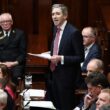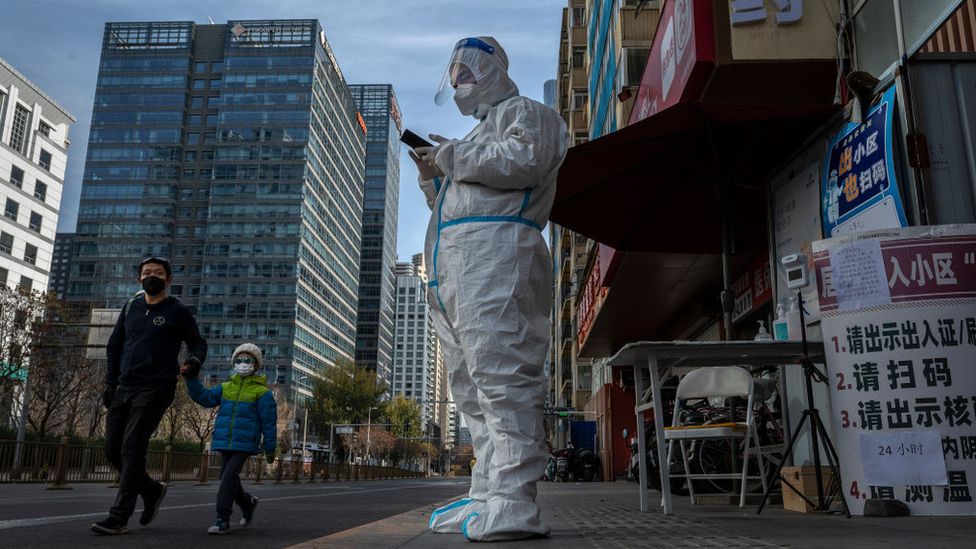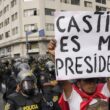Editorial from《社会主义者》(Socialist) magazine of ISA in China, Hong Kong and Taiwan
As the Chinese New Year approaches, China is again the epicentre of the global pandemic. Despite a total information blackout, it is clear the country is experiencing an explosive spread of the virus after suddenly abandoning its three-year Zero COVID policy of hardline controls. This has been replaced by a chaotic “laissez-faire” position of minimal state intervention and everyone fending for themselves. We are undoubtedly witnessing one of the most shocking and sickening episodes in the history of the pandemic, which has seen many shocking and sickening episodes. Dictator Xi Jinping, the architect of the current crisis, therefore approaches the Year of the Rabbit as a much weaker ruler than he was one year ago. Internally and on the global stage, Xi has been massively cut down to size.
The so-called Communist Party (CCP) dictatorship has completely lost control over its pandemic management policies. This has happened due to the pressure of a worsening long-term economic crisis and then — crucially — the most significant anti-government protests seen in China for three decades. With the CCP regime driven to panic by the protests, which erupted in late November across 39 cities and 160 university campuses (as far as we know at this stage), the Zero COVID strategy which Xi held up as the best in the world has collapsed into chaos. No matter how much the regime attempts to present this about-face as a controlled and prepared “optimization”, this fools nobody because people can see the turmoil with their own eyes.
The cost of this fiasco in social, economic, and health terms, is being borne by the Chinese masses, especially the poor (more than 600 million people) and the elderly (200 million aged 65 and above) as COVID rips through the world’s most populous country. The political cost will be paid at some point by Xi Jinping himself. The crisis in his regime, of which we have spoken before, is now hugely magnified by the outbreak of protests and the shambolic nature of this u-turn. Splits at the top and new sharp outbreaks of intra-regime power struggle are to be expected.
While the November protest wave subsided within a matter of days, checked by a predictable bout of repression, new and bigger waves are inevitable in the future. The working class — the force most feared by the CCP — will be thrown into new struggles, as we have already seen in the Chongqing protests involving thousands of sacked medical supply workers (more victims of Xi’s pandemic u-turn) in early January. As we said at the time of the November protests, they changed China. It is as if a dam has burst, even a psychological one inside the heads of 1.4 billion people. Chinese youth, women and workers are now thinking more politically, coming to terms with a newfound awareness that the country is in a state of mass discontent, with a dictatorship that can be challenged. From this realisation, there is no turning back. It doesn’t matter how much the truth is denied by the media and propaganda machinery of the state.
“Put life first”
The CCP’s Zero COVID u-turn, or rather implosion, has plunged the country into a major public health crisis and even more economic distress. This makes a mockery of Xi’s boast that his pandemic policies “put the people first and put life first”, a claim he repeated in his televised New Year speech. In the history of the pandemic to date we have not seen anything on such a scale. Globally, after more than three years of pandemic, the total number of infections is 670 million as of 13 January. But cases in China have already in all likelihood exceeded this number. Under the dictatorship’s censorship we don’t have any data. But in Henan province alone the number infected has reached 88.5 million according to provincial health official Kan Quancheng at a press conference on 10 January. This compares to the Chinese government’s official claim of only 120,000 infections across the whole country.
It seems that thousands are dying every day despite the milder character of the Omicron variants. Airfinity, a UK-based health data company, which uses modelling based on data from Chinese provinces before the recent changes in how cases are reported, estimates that 100,000 Chinese died of COVID in December. Its model predicts the cumulative death toll will reach 584,000 by the end of January.
It is hard not to agree with Yanzhong Huang of the Council on Foreign Relations, a US think-tank, that the collapse of the Zero COVID policy has caused “maximum virus spread”, with the CCP now pushing the “population to achieve herd immunity as soon as possible”. Most people are dumbfounded by the manner of the CCP’s reopening, without even a minimum of preparation either through a renewed vaccination drive or increased resources for hospitals. “Why wait three years to then do this?” is a question many people are asking.
In the South China Morning Post, George Magnus, a research associate at Oxford University’s China Centre, said the CCP had, “wasted its three years of zero COVID commitment for nothing, ending up with costs and scars that will linger for a long time”. Xi’s almost unfathomable COVID mess is rooted in the limitations of the authoritarian CCP-state, and its powerful internal contradictions. Many observers see the Chinese capitalist dictatorship as a technocratically effective, if brutal, state machine. But in reality the CCP does not exercise as much control as it pretends.
CCP policies tend towards extremes in one direction and then the other following a zigzag pattern. Local and regional governments which play an extremely important role in China’s political system and economy, operate by second guessing what the centre wants, not daring to openly question or to admit problems. This produces a governance model that cannot easily multitask or “walk and chew gum at the same time”. In moments of severe crisis and stress these contradictions jam the system, with paralysis as the end result.
Ended accidentally
Zhuoran Li in The Diplomat believes Xi’s regime unintentionally ended its Zero COVID regime — it was an “accident”. After securing his goals at the CCP’s 20th Congress, which declared it would “continue dynamic zero COVID without hesitation” (20th Congress Report), it seems that Xi’s newly strengthened (superficially, as we explained) ruling team planned a gradual phase out of the policy, with a full reopening of China’s economy to be achieved some time in the second quarter of this year. This probable timeline is connected to the regime’s hopes for one or more Chinese-made mRNA vaccines to become available. At least six Chinese companies are reportedly developing mRNA vaccines, but none have so far been approved.
This plan reflected the massive pressure on Xi’s regime from the economy, which despite the inflated official GDP data is close to recession or no growth. This in turn impacts the US-China geopolitical struggle, an existential struggle for the CCP, with China economically now no longer playing catch up with the US. Western decoupling from China, while still in its early stages, is a serious problem. Xi’s boastful talk about developing the domestic economy (so-called dual circulation) is now recognised as a lot more difficult than he claimed.
A sign of the new political course came on 11 November, when Beijing published a “20-point program” on COVID control, the aim of which was to reduce excessive lockdown measures. But this contradicted the message of the 20th Congress, where Zero COVID was portrayed as a semi-permanent institution, and the CCP’s local administrations were thrown into a state of confusion. In November, with Omicron cases surging, the number of new lockdowns increased dramatically. The disconnect between Beijing’s intentions and how the regions interpreted them grew wider. Some city governments announced the end of lockdowns, but continued them in practise.
When mass protests erupted at the end of November this spread panic throughout the CCP apparatus. The situation became urgent. The protests were only a warning of the much bigger social explosion developing beneath the surface. Fearing more protests, Beijing stepped up the pressure on local governments to carry out the “20 points”. But the result was chaotic, a collapse, rather than the step-by-step process that Xi’s ruling group had envisioned. Even on 7 December, when the central government issued its supplementary “10 points”, its spokesperson insisted the new policy does not mean China will “completely open up” but rather would change incrementally by “taking small steps.”
However, as Zhuoran Li explains: “The rushed opening-up did not come from Beijing; it resulted from local governments interpreting central government signals and getting ahead of Beijing regarding policy implementation.
“Facing the sudden opening at the local level, Beijing realised that ‘the horse has already left the barn’; all it could do was accept the reality.” (Zhuoran Li, The Diplomat, 7 January 2023)
The main cause was mass pressure and the regime’s fear of more protests. The dynamic this produced was to open the cracks within the CCP-state, between the regions and the centre. This course of events is full of lessons for how other political and economic crises can unfold in the next period. This is also one of the reasons, a very important one, why the CCP dictatorship especially under Xi is so averse to any relaxation of its repressive powers or authoritarian controls. Not only does it fear the masses, that an inch conceded will become a mile, but it also fears losing control over its own gargantuan state machinery.
A study by researchers at the University of Macau and Harvard Medical School published on 22 December warned of 1.5 million deaths in the next six months. This study said the deaths could be reduced to 190,000, “in a model where 90 percent of the population received three doses of mRNA vaccines, and 75 percent of those infected with Covid-19 were prescribed Paxlovid — an antiviral treatment for highly vulnerable patients that reduces the chances of severe symptoms.” (South China Morning Post, 27 December 2022). But the current policies of the government mean this lower figure is unlikely to be achieved.
Protecting capital
Xi’s regime has blocked the import of foreign mRNA vaccines, which are far more effective than China’s homegrown vaccines that use older technology. The ban is for political reasons, of injured nationalist pride, and means that even an offer from the EU in January, through its health commissioner Stella Kyriakides, to send free mRNA vaccines to China, was rejected by the foreign ministry, saying the vaccines were not needed and the situation in China is “under control” — a laughable statement.
The ban on foreign mRNA vaccines is also driven by economic protectionism. The CCP, which represents the interests of the Chinese capitalists, fears that green lighting foreign vaccines will strengthen their position in China’s healthcare market at the expense of profits for the domestic capitalists. So much for “putting life first” when it is rather the CCP’s corporate interests that are being protected. Zero COVID has meant a three-year long boom for China’s pharmaceutical sector, with total profits of 700 billion yuan (US$104 billion) in 2022. Beijing wants to pressure Western companies like Moderna to hand over their technology to Chinese companies, something the notoriously hardnosed Western pharmaceuticals won’t do, for obvious reasons, and which the US and other governments are increasingly enforcing as part of the US-China Cold War.
The low efficacy of China’s currently available vaccines (Sinovac and Sinopharm) has become a major impediment to fighting the pandemic. They were developed to protect against the older variants of the virus and are today, even with booster shots, much less effective against the highly contagious Omicron variants.
This has reinforced the widespread vaccine reticence among the key demographic — the elderly — who even with the much lower mortality rates of Omicron are still at risk of serious illness or death. Because the CCP’s vaccine rollout in 2021 took the opposite approach to most other countries, putting the main focus on vaccinating the working age population, China’s vaccines are widely seen as unsafe for those aged over 65 years.
The reluctance of the CCP’s top leadership — mostly senior citizens — to show themselves getting vaccinated, hasn’t help to assuage these fears. This is now a huge problem. Ninety million people over the age of 60 are not fully vaccinated. And 23.8 millions of these have yet to receive their first jab. The refusal to get vaccinated among many older Chinese is entrenched, and the regime has so far not dared to impose mandatory vaccination fearing this would trigger protests.
The nationalist hypocrisy over Western vaccines is exposed by the rampant price gouging with Paxlovid, an antiviral medicine made by Pfizer, which is available in China. A single packet of Paxlovid, containing three tablets, is now selling for as much as 50,000 yuan (US$7,313) online, according to local media reports, against the original price of around 2,000 yuan. The wealthy are hoarding the drug which is a literal lifesaver in the current crisis. Given that Paxlovid is in very short supply in China, it has reportedly replaced Maotai, a luxury brand of liquor, as the best way to bribe CCP officials.
The likely horrors that await the Chinese people as waves of the pandemic sweep the country will intensify the mass anger against Xi’s regime. This anger now has a point of reference that was missing before the November protests, a starting point for working out ideas of how to organise against dictatorship. Socialists need to seize these new possibilities to point to the crucial need for independent working class organisations, fighting labour unions and a workers’ party, with the aim of linking the widespread opposition to oppression and inequality to the need to end capitalism and dictatorship.











